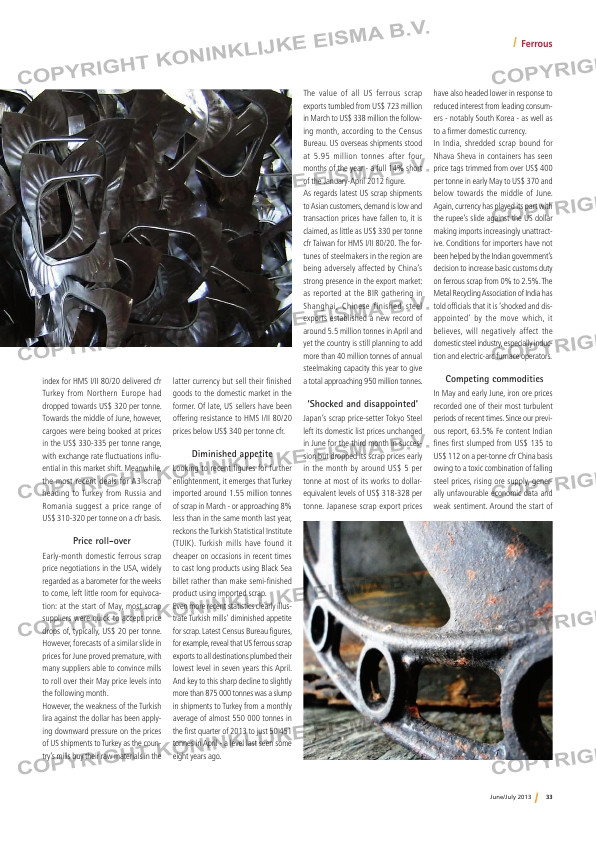Page 33 from: June / July 2013

33June/July 2013
Ferrous
index for HMS I/II 80/20 delivered cfr
Turkey from Northern Europe had
dropped towards US$ 320 per tonne.
Towards the middle of June, however,
cargoes were being booked at prices
in the US$ 330-335 per tonne range,
with exchange rate fluctuations influ-
ential in this market shift. Meanwhile,
the most recent deals for A3 scrap
heading to Turkey from Russia and
Romania suggest a price range of
US$ 310-320 per tonne on a cfr basis.
Price roll-over
Early-month domestic ferrous scrap
price negotiations in the USA, widely
regarded as a barometer for the weeks
to come, left little room for equivoca-
tion: at the start of May, most scrap
suppliers were quick to accept price
drops of, typically, US$ 20 per tonne.
However, forecasts of a similar slide in
prices for June proved premature, with
many suppliers able to convince mills
to roll over their May price levels into
the following month.
However, the weakness of the Turkish
lira against the dollar has been apply-
ing downward pressure on the prices
of US shipments to Turkey as the coun-
try’s mills buy their raw materials in the
latter currency but sell their finished
goods to the domestic market in the
former. Of late, US sellers have been
offering resistance to HMS I/II 80/20
prices below US$ 340 per tonne cfr.
Diminished appetite
Looking to recent figures for further
enlightenment, it emerges that Turkey
imported around 1.55 million tonnes
of scrap in March – or approaching 8%
less than in the same month last year,
reckons the Turkish Statistical Institute
(TUIK). Turkish mills have found it
cheaper on occasions in recent times
to cast long products using Black Sea
billet rather than make semi-finished
product using imported scrap.
Even more recent statistics clearly illus-
trate Turkish mills’ diminished appetite
for scrap. Latest Census Bureau figures,
for example, reveal that US ferrous scrap
exports to all destinations plumbed their
lowest level in seven years this April.
And key to this sharp decline to slightly
more than 875 000 tonnes was a slump
in shipments to Turkey from a monthly
average of almost 550 000 tonnes in
the first quarter of 2013 to just 50 451
tonnes in April – a level last seen some
eight years ago.
The value of all US ferrous scrap
exports tumbled from US$ 723 million
in March to US$ 338 million the follow-
ing month, according to the Census
Bureau. US overseas shipments stood
at 5.95 million tonnes after four
months of the year – a full 14% short
of the January-April 2012 figure.
As regards latest US scrap shipments
to Asian customers, demand is low and
transaction prices have fallen to, it is
claimed, as little as US$ 330 per tonne
cfr Taiwan for HMS I/II 80/20. The for-
tunes of steelmakers in the region are
being adversely affected by China’s
strong presence in the export market:
as reported at the BIR gathering in
Shanghai, Chinese finished steel
exports established a new record of
around 5.5 million tonnes in April and
yet the country is still planning to add
more than 40 million tonnes of annual
steelmaking capacity this year to give
a total approaching 950 million tonnes.
‘Shocked and disappointed’
Japan’s scrap price-setter Tokyo Steel
left its domestic list prices unchanged
in June for the third month in succes-
sion but dropped its scrap prices early
in the month by around US$ 5 per
tonne at most of its works to dollar-
equivalent levels of US$ 318-328 per
tonne. Japanese scrap export prices
have also headed lower in response to
reduced interest from leading consum-
ers – notably South Korea – as well as
to a firmer domestic currency.
In India, shredded scrap bound for
Nhava Sheva in containers has seen
price tags trimmed from over US$ 400
per tonne in early May to US$ 370 and
below towards the middle of June.
Again, currency has played its part with
the rupee’s slide against the US dollar
making imports increasingly unattract-
ive. Conditions for importers have not
been helped by the Indian government’s
decision to increase basic customs duty
on ferrous scrap from 0% to 2.5%. The
Metal Recycling Association of India has
told officials that it is ‘shocked and dis-
appointed’ by the move which, it
believes, will negatively affect the
domestic steel industry, especially induc-
tion and electric-arc furnace operators.
Competing commodities
In May and early June, iron ore prices
recorded one of their most turbulent
periods of recent times. Since our previ-
ous report, 63.5% Fe content Indian
fines first slumped from US$ 135 to
US$ 112 on a per-tonne cfr China basis
owing to a toxic combination of falling
steel prices, rising ore supply, gener-
ally unfavourable economic data and
weak sentiment. Around the start of
RI-5_maFerrous.indd 33 17-06-13 15:58



